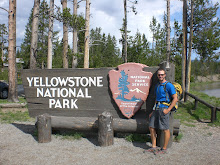Thursday, April 9, 2009
Double Aerification Extravaganza
Being a resort style course, revenue is correlated directly to the number of rounds played per golf season. In order to avoid losing potential rounds due to decreased quality of the playing surface, referring to fall aerification, the greens at the Straits course are double aerified. It is how it sounds, the greens are first aerified once, topdressed, dragged, then blown by buffalo blowers, and finally rolled. Those steps in that order are conducted prior to the second round of aerification, and then it is done all over again. Four aerifiers were used, two Ryan greensaire 24, a Jacobsen greensaire 24, and a Toro 648 procore. Each aerifier was set at two inch on center spacing, and the rationale here is that by double aerifying we will remove a great deal of thatch and organic matter deposition, thus substituting for the fall aerification. Our operation was delayed each day due to frost, as well as in one case the greens being frozen. Following punching, the cores were removed by a crew of approximately 12, snow shovels were used to remove the cores from the greens, and two individuals were also designated to backpack blowers in order to blow any remnants off the green prior to topdressing. The greens were topdressed using a Dakota spreader, and the topdressing sand matched spec with that used to construct the USGA spec greens. The greens were then dragged using a hydraulicly controlled brush, and then blown into the holes using buffalo blowers. In my mind the blowers were overkill, because you essentially are blowing sand off the green more so than into the holes, thus wasting your investment. I supposes it is all personal preference, but in this economy, and with budgets being tight at times, I would look to find a more proficient method of filling the aerification holes. The greens were then rolled using Smithco rollers in order to true the surface. Our approach was to aerify in a way that the greens would be playable without any adverse affects the next day. We have the luxury of opening later though, so it's not a big issue. We do not overseed following aerifications though, because we believe that the creeping bent on the greens is a vigorous lateral grower that will fill the voids without the addition of seed. Also, we manage fescue fairways, and with the wind dispersal via air is not uncommon. So we are also fending off the spread of bentgrass into the fairways by not topdressing. When you have a management program set for chewings fescue, it is set to allow that species to flourish, so if we have to manage for bent as well it becomes difficult and more intensive. Bentgrass enjoys a more moist environment, whereas chewings fescue does not like wet feet, and throughout the year we water infrequently due to the chewings great drought tolerance, so it will appear healthy, whereas the bentgrass will be losing pigmentation and yellowing out creating inconsistency in the uniformity. Lastly, during aerification we experienced the presence of black layer on number 11 on the Straits course at approximately two inches of depth. It was only located in a depression of the green where water filtered to drain tiles, and with the heavy soils in the region created a saturated soil, thus producing anaerobic conditions. In order to remedy the problem, I was told that for now all that is done in aerification and the implementation of topdressing sand. I apologize for the belated posts, but in my defense I must travel to a bar in order to get wireless service.
Subscribe to:
Post Comments (Atom)

"In my mind the (Buffalo) blowers were overkill, because you essentially are blowing sand off the green more so than into the holes, thus wasting your investment."
ReplyDeleteI experienced that using Flymo's do an excellent job in getting the sand into the aerification holes. Another good technique is slowly dragging a mat over the green while filling it constantly with dried sand. Both these practices are time consuming but give an excellent result. - Niels
more photos please!
ReplyDelete